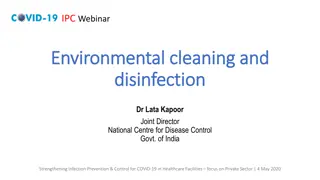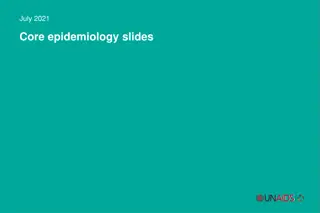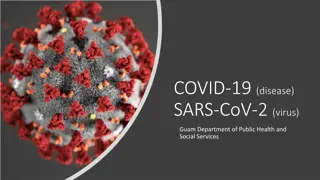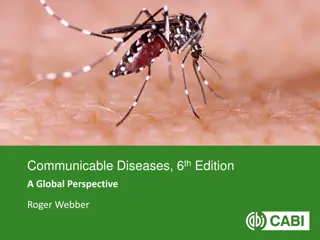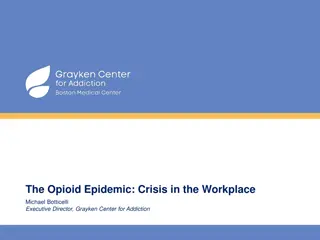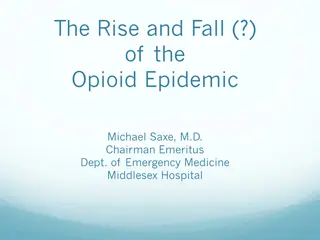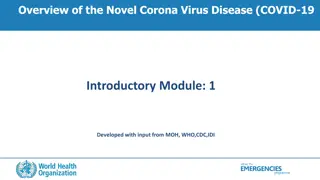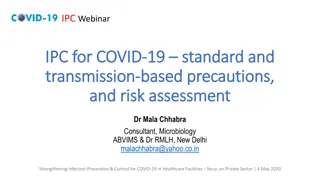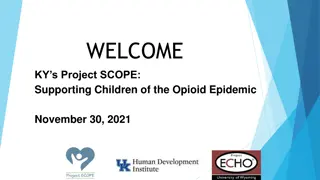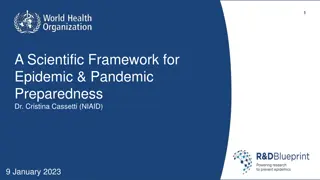Understanding the History and Epidemic Potential of Coronaviruses
Coronaviruses were first discovered in the 1960s, with strains such as SARS and MERS causing serious respiratory infections. The recent outbreak of the novel coronavirus in Wuhan, China, has raised concerns about its genetic relationship to previous strains. Named 2019-nCoV by WHO, this new virus has epidemic potential as coronaviruses continue to jump from animals to humans, posing new threats worldwide.
Download Presentation

Please find below an Image/Link to download the presentation.
The content on the website is provided AS IS for your information and personal use only. It may not be sold, licensed, or shared on other websites without obtaining consent from the author. Download presentation by click this link. If you encounter any issues during the download, it is possible that the publisher has removed the file from their server.
E N D
Presentation Transcript
1.HISTORY OF CORONAVIRUS INFECTION .2 NAMES OF CORONAVIRUS CAUSING THE INFECTION SARS & MERS 3. MECHANISM OF ITS DEVELOPMENT 4. PATHOLOGY AND CLINICAL SYMPTOMS 5. DIAGNOSTIC METHODS
Coronaviruses History CORONAVIRUSES WERE DISCOVERED IN THE 1960S; THE EARLIEST ONES DISCOVERED WERE INFECTIOUS BRONCHITIS VIRUS IN CHICKENS AND 2 VIRUSES FROM THE NASAL CAVITIES OF HUMAN PATIENTS WITH THE COMMON COLD & NAMED HUMAN CORONAVIRUS 229E AND HUMAN CORONAVIRUS OC43.
OTHER MEMBERS OF THIS FAMILY HAVE SINCE BEEN IDENTIFIED, INCLUDING I.SARS-COV IN 2003 CHINA II.HK COV IN 2005, - HONG KONG III.MERS-COV IN 2012, IV.WUHAN 2019-NCOV - CHINA; MOST OF THESE HAVE BEEN INVOLVED IN SERIOUS RESPIRATORY TRACT INFECTIONS
The Wuhan strain has been identified as a new/novel strain of CoV from group 2B with an ~70% genetic similarity to the SARS- CoV, the new strain has been named 2019-nCoV by the WHO
_ The name "coronavirus" is derived from the Latin corona and the Greek , meaning crown _ This refers to the characteristic appearance of virions (the infective form of the virus) by electron microscopy, showing an image resemble to a royal crown
EPIDEMIC POTENTIAL OF WUHAN CORONA VIRUS Coronaviruses are jumping increasingly from animals to humans, creating new threats
The Novel Coronavirus, 2019 - Overview _RECENT OUTBREAKS OF PNEUMONIA IN WUHAN, CHINA WAS CAUSED BY A NOVEL BETA CORONAVIRUS _SPECIMENS COLLECTED AND ANALYZED FROM PATIENTS USING REAL TIME-PCR AND NEXT GENERATION SEQUENCING IDENTIFIED IT TO BE A VIRUS MEMBER BELONG THE FAMILY OF CORONA VIRIDAE, A NOVEL BETA CORONAVIRUS 2019 _IT OCCURRENCE HAS RAISED QUESTIONS INTO THE GENETIC RELATIONSHIP AND SIMILARITY TO SARS CORONA VIRUS OF 2003 CONSIDERING THAT THEY BOTH OCCURRED IN CHINA NOT FAR FROM WUHAN .
_ According to CDC (Centers for Disease Control and Prevention) & WHO data, which indicates the difference between the novel virus and SARS. SARS is more severe than the new novel virus but the last one is more contagious than SARS (More Infectivity & Spread). _Factors like a transmission from an animal to person and person-to-person and nosocomial spread have been the routes of consideration with more reports leaning to an animal to person transmission considering first sight of infectivity was a wet market and person-person transmissions, but yet to be verified. _ Traveling has enhanced the spread of the virus to various countries with great concern about an epidemic outbreak of this specific virus. _In the past two decades, 3 variants of coronavirus emerging causing serious epidemic diseases of the respiratory tract system indicating that the virus continues to impose continuous threats to human health & affecting the economy & catastrophic consequences
HAVE A LONG INCUBATION PERIOD OF 1-14 DAYS. THE PATIENTS REMAIN ASYMPTOMATIC UNTIL THE OCCURRENCE OF THE DISEASE, PRODUCING SEVERE UPPER AND LOWER RESPIRATORY TRACT INFECTIONS.
Epidemiology of Coronavirus As of 28 January 2020: World Cases: 4,673 confirmed cases with 106 deaths. China Cases: 4,596 confirmed cases with 106 deaths. 63 person has been recovered from 2019-nCoV.
Epidemiology of Coronavirus From the data collected by the CDC, the persons at risk are 1.Elderly individuals above 50 years specially those with underlying chronic diseases e.g. diabetes, & cardiovascular diseases. 2.Demographically, persons living in China around Wahun are most at risk, especially those dealing with Animal; and persons traveling into and out of Wahun. 3.Hospital-acquired infection- Health care workers caring for patients with the Wuhan 2019 coronavirus
Clinical Signs of 2019-nCoV of Coronavirus Manifestations are mild and/or progressive in some cases to severe symptoms that can eventually lead to death. These include 1.Fever associated with flu-like symptoms of coughing, headache 2.Upper or/and lower respiratory tract symptoms associated with shortness of breath and breathing difficulties 3.Diarrhea after the virus colonizes the epithelial lining of the GIT
4.General body weakness and myalgia (fatigue) 5.In severe cases, individuals produce symptoms of pneumonia with abnormal chest CT, hemoptysis, lymphopenia, associated with complications of severe acute respiratory distress syndrome, acute cardiac injury, kidney failure and eventually, death.
Transmission of 2019-nCoV of Coronavirus 1.Animal to Human transmission (Examples: camels, cattle, cats, and bats) 2.Human to Human transmission (via blood, stool, urine, saliva, semen) 3.Nosocomial transmission from infected patients to caregivers and health care worker The spread of virus could occur when a person touches a surface or object that has a virus on it and then touches his or her own mouth, nose, or possibly their eyes (Cross Infection)
How is the virus spread among humans? Seven strains are known to infect humans, including the virus in Wuhan. They can be spread by coughing, kissing or making contact with saliva, Chinese officials say. Four of the strains cause common colds.
Coronaviruses: From Animals to Humans Researchers aren't sure how the novel coronavirus first infected people in China, but the viruses that cause SARS and MERS, which originated in bats, provide clues. .Coronaviruses can also jump directly to humans, without mutating or passing through an intermediate species. 4.Researchers aren't sure from Q1- what animal the novel coronavirus originated? or Q2- whether it passed through an intermediate species before infecting humans?? Source: Timothy Sheahan, University of North Carolina Alberto Cervantes and Josh Ulick /THE WALL STREET JOURNAL
Diagnosis of 2019-nCoV of Coronavirus Specimens: 1. Respiratory materials including Nasopharyngeal & oropharyngeal swabs, sputum / endotracheal aspirate or bronchoalveolar lavage in patients with more severe respiratory disease. 2. Tissue biopsies 3. Whole blood 4. Urine samples 5. Serum for serological testing NB: Collection of the samples should be done with CAUTION and all samples regarded as potentially infectious with regard to strict adherence to Infection Prevention and Control guidelines.
Clinical diagnosis: Observing patient symptoms. This includes; fever, headaches, myalgia, sneezing, and coughing. If the patients meet the case definition of the suspected 2019-nCoV, he/she should be screened for the virus with PCR. Laboratory Diagnosis: Currently, the diagnostic tests available are aiming at conventionally detecting the causes of pneumonia early, to support disease control activities and to work with reference Labs that can perform pan coronavirus detection and directed sequencing. (WHO/2019-nCoV/laboratory/2020.3).
Diagnosis of 2019-nCoV of Coronavirus The recommended diagnostic methods include: 1. Isolation of the virus in human airway epithelial cells 2.Use of pan-coronavirus assay for amplification 3. Followed by RT-PCR assay designed to detect Virus sequences 4. Serological testing e.g. cytokine identification, measurement, and quantification.
Prevention & Control of 2019-nCoV Coronavirus Maintaining basic hand and respiratory hygiene. Avoid close contact, with anyone showing symptoms such as coughing and sneezing. Avoid contact with farm or wild animals such as bats. The consumption of raw or undercooked animal products should be avoided. People can stay at home if they are sick. Cleaning and disinfecting frequently touched objects and surfaces.
References 1.Microbiology Notes Reveiws 2.Jawetz, Melnick, & Adelberg s Medical Microbiology, 28e 3.David Greenwood, Medical Microbiology 4.Topley and Wilson s Microbiology and Microbial Infections, 8 Volume Set, 10th Edition 5.Schaechter s Mechanisms of Microbial Disease 6.http://www.nejm.org/doi/full/10.1056/NEJMc1509458?rss=searc hAndBrowse&#t=article 7.http://www.asmscience.org/content/book/10.1128/9781555815 790.ch20 Internet Sources (Google Scholars & Pubmed Papers)
THANK YOU FOR ATTENTION . TREIMAKASIH



